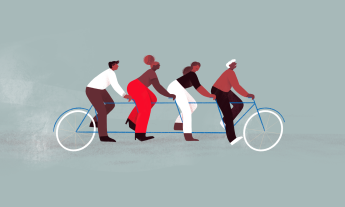
By using the first day as a time for people to tap into their best selves — and not just fill out paperwork — companies could ease their stress and bring out their full potential, says business school professor Daniel Cable.
“There is a new war for talent happening in the workplace today,” says London Business School professor Daniel Cable. “And it’s not about wooing employees away from competitors, but unleashing the enthusiasm that is already within employees, just dormant.”
Cable has spent the past five years studying what helps people activate their best selves. Here, he describes an experiment that focused on a very simple — but effective — intervention aimed at new hires.
When Adesh woke up in his Delhi flat, his mind was consumed with the fact it was his first day at work at Wipro, an Indian IT company. Even though this was his fourth job since he left university, he was anxious. Making first impressions on coworkers, struggling to fit in, making sure he was as good as everyone else — it was all stressful.
He was worried about his new role, too. As a call-center rep, he’d be talking with faraway customers and trying to solve their problems with their printers or booking their flights. This was all new to him — while he’d done some chat support, he’d never assisted anyone live, halfway around the world, on the phone before.
Even though this was a great job, Adesh knew parts would be a grind. Since he’d be assisting people in the US, he had to work during their business hours — his shifts would begin at 9 PM and go through the night. He’d need to deal calmly and professionally with frustrated customers, who might be rude and disrespectful. He’d also have to adopt a Western accent and attitude. New reps tended to quit after just a few months.
When Adesh arrived at the Wipro campus, he was shown into a room with 18 other new hires. Having been onboarded at previous jobs, Adesh knew the drill: admin types would show up, and he and his colleagues would fill out paperwork and sit through an orientation about their job responsibilities.
After a few minutes, a man walked through the door and introduced himself as a senior Wipro leader. Adesh was surprised; the man wasn’t from HR. Instead of talking about procedures and responsibilities, the leader spent 15 minutes discussing why Wipro was an outstanding company. “Working at Wipro gives you the opportunity to express yourself,” he told the group.
Unlike most new-hire trainers, he didn’t seem to be reading from a script. After sharing stories about his time at Wipro, the man asked the new hires to take a few minutes and write an answer to a question: “What is unique about you that leads to your happiest times and best performance at work? Reflect on a specific time — perhaps on a job, perhaps at home — when you were acting the way you were ‘born to act.’”
Starting a new job is like visiting a foreign country: everything’s unfamiliar, and we can’t rely on previous relationships, routines and assumptions.
Adesh stared at the blank paper. He knew Wipro was different, but he hadn’t expected to delve into his personal life at orientation. But, after a few moments, he thought about helping his 12-year-old nephew Anil with his math homework.
Anil couldn’t understand how to use the rules of geometry to figure out the degrees of an angle. Frustrated and angry, he crumpled his paper. With a little effort, Adesh calmed his nephew down. Then he walked him through the rules. “Look, Anil, a flat line is always 180 degrees,” he said. “Let’s write that here. And if you know this angle is 50 of those degrees, then how much does the other need to be?”
Adesh continued helping Anil for 30 minutes, slowly guiding him. Before long, Anil was getting it, racing ahead without asking questions and gathering confidence. When Adesh was leaving, Anil whispered, “Thank you for helping me.” But Adesh didn’t need to be told — he saw the gratitude on his nephew’s face.
Now, at his orientation, Adesh happily wrote down this memory.
“You haven’t met each other yet,” the Wipro leader said after everyone was done writing, “but you’ll be doing a lot of training together. So get together and introduce yourselves. But I want each of you to introduce your best self. Perhaps read the story you wrote and tell the group what it says about you at your best.”
Adesh felt good telling his story and listening to everyone else’s. He felt his new colleagues already knew a lot about him, and vice versa. In this moment, he felt like his best self. After they all finished, the leader gave each person a badge and a sweatshirt customized with his or her name.
Organizations know starting a new job is a vulnerable situation — so they use it to get employees to absorb their values and way of doing things.
We’ve all been in Adesh’s shoes. When we join a new organization, the first weeks are a blur. There are confusing acronyms thrown at us; we need to figure out what topics are acceptable and unacceptable to discuss in meetings and over lunch; we need to learn what our priorities are. It’s like visiting a foreign country: everything’s unfamiliar, and we can’t rely on our previous relationships, routines and assumptions.
It’s also a time to experience the basic human need to fit in and be accepted — in this case, by our new managers and coworkers. It’s a vulnerable situation to be in. Organizations know this, which is why they use the orientation period as a time to get their employees — a rapt, needy audience — to absorb their values and their way of doing things.
There’s nothing wrong with this. It’s important for workers in companies, especially big ones, to share a common purpose. But when my colleagues and I studied 605 new Wipro employees across three different operations centers in India, we discovered there could be a better way of onboarding new hires. Through our studies and experiments with Wipro, we ended up developing the new orientation process that Adesh just took part in.
By sharing their personal stories at the start, new hires could express themselves more fully, showing colleagues their most valued traits.
As we found (and confirmed in later studies), an orientation where newcomers wrote about their best selves, and shared those stories with their new coworkers, led to greater performance and retention. Perhaps more important, it connected employees more closely to their organizations.
In our experiment, we randomly assigned new hires to one of three conditions. In the first condition (described above), new employees were asked to write about times they used their best characteristics, and shared these accounts with the group. At the end of the session, they received their work badge and a personalized sweatshirt. In the second condition, the new hires were asked to spend 15 minutes reflecting on the senior leader’s remarks. After discussing their answers with the group, people received a badge and a generic sweatshirt. New hires in the third condition, or the control group, went through Wipro’s regular orientation, which focused on skills training.
After tracking the participants for six months, we found that Adesh and his colleagues in the “best self” condition outperformed their peers who had participated in Wipro’s typical onboarding. Their customers, for example, reported 11 percent higher satisfaction (72 percent vs. 61 percent). We also found the “best selves” group were more likely to remain in their jobs: retention improved by 32 percent. Results for the second condition (who reflected on the talk about Wipro’s values) were interesting too. Compared with the control condition, it reduced quitting by 14 percent — but did not lead to significantly better customer satisfaction.
Does everybody have a best self? Yes. It’s the story we tell about ourselves, and it affects how we act and how others respond to us.
At Wipro, we tried what psychologists call a “wise intervention” — something new and small that has disproportionately large effects, because it fixes something that makes people feel emotionally vulnerable. Our experiment likely had that effect because the new hires were anxious about meeting their coworkers. In those situations, we tend to highlight the parts of ourselves that conform to the group and fit the expectations of others. This can be exhausting and stressful.
The best-selves intervention alleviated this problem. By sharing their personal stories at the start, the new hires could express themselves more fully, showing their colleagues their most valued behaviors and traits. As a consequence, they were viewed by their coworkers in the way they wanted to be seen — and they felt like their best selves.
Does everybody have a best self? Yes. Remember, a self is just a story that we tell ourselves. It is not objective — you can’t see it or touch it. But it is very real in the sense that the story affects how we act and how others respond to us. If we change the story we tell about ourselves, we change our behaviors. As organizational psychology professor Laura Roberts and colleagues at the University of Michigan have defined it, a best self is “the cognitive representation of the qualities and characteristics the individual displays when at his or her best.”
Our best selves are not projections of what we could become someday — they’re based on our real-life experiences and actions. And the more our colleagues know who we are when we’re at our best, the more likely we can feel like ourselves at work.
We suspected that this was why the people who experienced the wise intervention stayed so much longer and made clients happier: because they could express themselves more authentically. That would bond them to Wipro in a different way. As Amit, one of the onboarding managers who helped with the study, told me: “People were proud to be recognized as individuals. This gave them a distinctive identity within the organization and helped them identify with the organizations much faster. They felt very connected to the organization at that time.”
It’s important to keep in mind that a best self is just one of a host of identities that each of us inhabit depending on the circumstances. Sometimes our most prominent identity might be as a father or a daughter; other times it might be as an academic, manager or writer.
If we feel like work is more like “real life,” we’re more apt to help our organizations adapt, innovate and stay relevant.
The best self, like our other identities, needs to be activated. But as we saw at Wipro, it doesn’t take much to do that. Because of our intervention, the new hires felt as if they were encouraged to seek what was best and unique about themselves and share it with colleagues as they were first meeting them, which gave additional meaning to their work. This likely led them to exhibit their best traits more often. Since their coworkers and managers appreciated their unique skills and traits, they were able to act more freely and authentically in subsequent interactions.
The best thing about best-self activation is it creates long-term effects. For example, after his activation, Adesh reported experiencing positive emotions, such as enthusiasm, which prompted more creative information processing, and this resulted in more productive responses to stress. Better creativity and better interactions with colleagues and customers further affirmed his best self, which led to yet more positive emotions and performance, further affirming that self, and so on.
“Companies need the contributing vitality of all the individuals who work for them in order to stay alive in the sea of changeability in which they find themselves,” writes author and poet David Whyte (TED talk: A lyrical bridge between past, present and future) in the book Crossing the Unknown Sea: Work as a Pilgrimage of Identity. “They must find a real way of asking people to bring these hidden heartfelt qualities to the workplace. A way that doesn’t make them feel manipulated or the subject of some five-year plan.”
It’s up to leaders in organizations to address this problem, and activating people’s best selves is a great way to do it for two reasons. First, it’s good for us — research shows that when people identify and use their unique strengths, they report feeling “more alive” or “intensely alive.”
Second, if we feel like work is more like “real life,” complete with intrinsic motivations and positive emotions, we’re more apt to help our organizations adapt, innovate and stay relevant. This can pay huge dividends to companies, including, as Whyte writes, “more adaptability, vitality, imagination, and the enthusiastic willingness to go the extra mile — qualities which are ancient and which humans have wanted for themselves since the beginning of recorded history.”
Excerpted with permission from the new book Alive at Work: The Neuroscience of Helping Your People Love What They Do by Daniel Cable, published by Harvard Business Review Press. Copyright © 2018 by Daniel M. Cable.
Watch his TEDxLondonBusinessSchool talk here:












